Balogun Ojetade's Blog, page 20
March 4, 2014
BEYOND SWORD & SOUL: Charles Saunders, the Father of Dieselfunk!
 For this year’s Black History Month, I – along with author Milton Davis – was asked to teach a class on Steamfunk at GA-Tech.
For this year’s Black History Month, I – along with author Milton Davis – was asked to teach a class on Steamfunk at GA-Tech.
For the class, the students read my story from the Steamfunk anthology, Rite of Passage: Blood and Iron and Milton’s story, The Delivery.
Milton read an excerpt from his upcoming, long-awaited Steamfunk novel, From Here to Timbuktu.
I decided to introduce the students to some Dieselfunk, so I read them an excerpt from my novel, The Scythe.
A few days later, I received an email from a student from Howard University – news travel fast in this Age of the ‘Net – who congratulated me on “another first.” In addition to my “stellar accomplishment” in authoring the first Steamfunk novel, Moses: The Chronicles of Harriet Tubman, according to the student, I was also the first to author a Dieselfunk novel, as well.
While I appreciated the compliments, I had to correct the student. I told her that the first Dieselfunk novel was actually written by one of my idols, who I’m sure didn’t even know he was writing Dieselfunk at the time, as I didn’t know I was writing Steamfunk when I wrote Moses: The Chronicles of Harriet Tubman. I was just writing alternate history with some cool gadgets, enhanced abilities, the supernatural and a bit of magic.
“If not The Scythe,” she asked. “Then what is the first Dieselfunk novel?”
“Damballa,” I replied. “Damballa, by Charles R. Saunders.”
“What is Damballa?” She emailed me back.
I replied thusly:
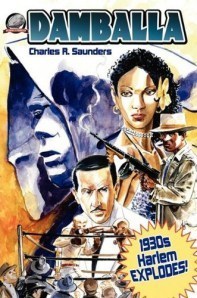 Damballa is Jazz. African science. Western science. A hooded, Black hero. Two-fisted pulp action.
Damballa is Jazz. African science. Western science. A hooded, Black hero. Two-fisted pulp action.
Such is the stuff that makes Damballa the unique and awesome Dieselfunk read that it is.
A classic costumed pulp hero, the black-hooded Damballa steps out of the forests of Africa and onto the streets of 1930s Harlem to battle Nazi’s bent on proving the superiority of the Aryan race.
Damballa (2011) is an incredible pulp adventure written by author Charles R. Saunders, the founder of the subgenre of Fantasy fiction called Sword and Soul and creator of the Fantasy icon Imaro.
The action does not stop as the titular hero uses his vast knowledge of Western science, African science and martial arts to expose and neutralize the Nazi threat.
Set in Harlem in 1938, the world is on the cusp of World War II and the Nazis are bent on proving their racial superiority.
The world heavyweight boxing champion, an African-American named Jackhammer Jackson, is challenged to a title match by the Nazis. Their representative is Wolfgang Krieger, a freakishly strong and massive man known as the “Aryan Adonis”. Krieger possesses inhuman power, which the mysterious Damballa believes has been bestowed upon him by Nazi scientists in an attempt to prove their racial superiority.
Aided by African-American NYC detective Bynoe and the brilliant Congolese elder woman Mamadou, Damballa hatches a plan to neutralize the Nazis’ fiendish plot.
Saunders layers this intriguing plot with historical details that recreates post-Renaissance Harlem to perfection.
Damballa is a shining example of what Dieselfunk is and what Pulp is when it is at its very best: thrilling, visceral, tightly-plotted, well-written, fast-paced fun and the hero, Damballa, is a shining example of what a pulp hero in the hands of a master can be: a hero the reader can actually stand up and cheer for; a hero with qualities and with a story other authors do their damndest to echo in their own creative and original ways.
Saunders delivers a masterful blend of storytelling, film noir, and boxing, with an eye-popping cover by Charles Fetherolf and interior illustrations by Clayton Hinkle that combine to make Damballa an instant pulp classic you do not want to miss!
“I must read The Scythe and Damballa now,” the student said. “But are they Dieselfunk or are they Pulp?”
“Both,” I replied. “Dieselfunk is a subgenre; Pulp is a style. Science Fiction, Sports Fiction, Crime Fiction, even Romance can all be written in the Pulp style, however, they are all quite different subgenres.”
She asked me to share excerpts from my work that were of different genres but shared the Pulp style. I now share with you what I shared with her:
Dieselfunk
 The Scythe stormed into Ernest Woodruff’s office suite.
The Scythe stormed into Ernest Woodruff’s office suite.
La Vipère Noire burst into the room behind him. She was dressed in a matte black cat-suit, studded with tiny black beads. Her boots, gloves and even her derby were all similar studded in a reptile scale pattern. A black bandana concealed her face from her cheeks to her chin. Her derby was pulled low over her forehead and tilted slightly to the left.
The two vampires sitting on post leapt from their seats.
“Viper, take the one on the left,” the Scythe said.
“Got him,” the Black Viper said sauntering toward the vampire.
She extended her right arm, revealing a small, tubular, metallic flashlight in her fist. She pressed a button on the flashlight and bright, white light washed over the vampire’s face.
The creature laughed heartily. “Sunlight hurts vampires, dinge; not tungsten filament-light!”
The Black Viper whipped her left leg toward the vampire’s head in a wide arc. As her leg passed through the light, the studs on her leg seemed to swallow it for a moment and then spit the light out with the intensity of two suns.
The vampire screamed in agony as his flesh blistered and charred.
Viper’s shin slammed into the vampire’s neck, separating his head from his shoulders.
The vampire’s body collapsed as his head bounced across his partner’s feet.
“Damn,” the Scythe said as the head rolled past him.
The surviving vampire leapt to the ceiling and then clung to it like a spider. He scurried toward the exit.
The Scythe vanished.
He reappeared right below the vampire and then thrust his right hand into the vampire’s back.
The vampire wailed.
“That’s your spine I’m holding,” the Scythe hissed. “The first vertebrae of your lumbar spine, to be exact.”
The Scythe slammed the vampire onto his face.
Brown blood sprayed across the black and white checkered floor tiles.
The Scythe yanked upward, ripping the vertebrae from the creature’s back.
The vampire gasped and then released a weak moan.
“He’s all yours, Viper,” The Scythe said.
The Viper held her left forearm in front of her flashlight. She turned the flashlight on and the black studs intensified the light to a blinding brightness. The intensified light struck the vampire, setting it ablaze.
The vampire cried weakly as it convulsed.
A moment later all that remained of the creature was ashes.
Fight Fiction
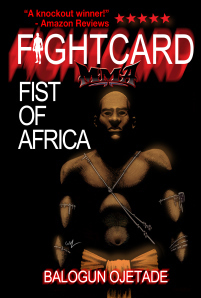 Thunderous applause rose from the dense crowd before Nick. The people parted, revealing a hulking figure sitting upon an iron throne, carved in the shape of a leopard resting on its haunches.
Thunderous applause rose from the dense crowd before Nick. The people parted, revealing a hulking figure sitting upon an iron throne, carved in the shape of a leopard resting on its haunches.
Agbu Tochi rose from the throne, looming above the crowd like a statue carved from onyx stone. His forearms were as thick as an average man’s thigh and appeared to be as hard as the throne he had just risen from. He slammed his cantaloupe-sized fist into his chest and the crowd roared. Tochi sprinted into the ring, charging directly toward Nick.
Nick swallowed his fear and stood his ground as the human locomotive called Agbu Tochi sped toward him.
The colossus stopped just inches in front of Nick, his massive chest almost touching Nick’s nose.
The giant stood still and in silence.
“Are you ready, Nick Steed?” Chizo asked.
Nick nodded.
“Are you ready, Agbu Tochi?”
Agbu Tochi tapped his chest twice with his fist.
Chizo slid her arm between the fighters. “Then, fighters take your places.”
Nick shuffled backward to his place at the edge of the ring. Agbu Tochi shambled backward to his place, his unblinking gaze locked on Nick’s throat.
“And now …” Chizo raised her hand high above her head, her fingers pointing toward the clear noonday sky. After a long pause, she brought her arm down sharply, slicing the air with her well-manicure fingers. “Fight!”
Agbu Tochi lurched forward. Nick charged forward to meet him.
Nick hammered into Agbu Tochi’s ribs with a volley of heavy right and left hooks. Agbu Tochi staggered backward.
Nick shuffled forward with a lead-hand hook toward Agbu Tochi’s chin.
The giant leaned back. The punch shot past his face. He then countered with a fierce cross, catching Nick square on the jaw.
Nick collapsed to his knees. He shook off the pain and exploded back to his feet, careful not to let his hands touch the ground. Both knees and a hand on the ground at the same time would be a loss by traditional rules.
Nick’s feet had barely touched the earth when he was lifted high into the air by the giant, who had grabbed him from behind in a tight bear-hug.
Nick thrust his leg to the outside of Agbu Tochi’s thigh, hooking his foot behind the giant’s knee. With the throw now blocked, Nick bent at the waist as he threw his palms toward the ground, breaking free of Agbu Tochi’s grip.
Nick thrust back and upward with his left foot, driving his heel into Agbu Tochi’s solar plexus. Agbu Tochi doubled over in pain.
Nick whirled toward Agbu Tochi, slamming a crushing shin kick into the outside of his thigh. Agbu Tochi’s leg buckled.
Nick followed with a second shin kick to the inner thigh of the same leg. Agbu Tochi’s leg quivered and he switched feet, bringing his left leg forward to protect his right leg from further onslaught.
Nick burst forward, wrapping his arms around Agbu Tochi’s waist and pulling him close. The giant thrust his massive right arm between his hips and Nick’s to partially break his grip.
The men mirrored each other, both holding the others left triceps with their right hand and waist with their left hand. They then fought for superior position, snaking their arms over and under each other in an attempt to grasp the other around the waist with both hands.
Nick proved to be a bit faster, lithely coiling his arms deep under Agbu Tochi’s armpits and then digging his fingers into the colossus’ sinewy shoulders.
Agbu Tochi shook furiously, but could not free himself from Nick’s boa constrictor-like control of his upper torso.
Nick thrust his hips forward as he punched his arms skyward under Agbu Tochi’s armpits, launching the massive wrestler high into the air. Agbu Tochi’s eyes widened. A hush fell over the crowd.
Nick torqued his hips as he arched backward, increasing the momentum of the throw. Both men struck the ground with a thunderous din. A cloud of sand billowed up from the ring.
So, there you have it – Dieselfunk and Fight Fiction, two different genres; both, very much Pulp Fiction; both inspired by my idol, Charles Saunders, the father and founder of Sword and Soul and Dieselfunk.


February 27, 2014
Punks Want the Funk! A Guest Blog by Jack Philpott
Greetings and salutations good people of Planet Earth. I am – once again – on board the Good Ship Sweet Chariot, traversing the aether in search of new Steamfunkateers to accompany me on a funktastic journey across the cosmos. So, this time around, I offer – without comment – a guest blog from world renowned Dieselpunk afficianado, Jack Philpott. He and a few other Dieselpunks have something to say about Dieselfunk and Steamfunk, so please, check it out.
And while I post this guest blog without comment, I ask that you, dear readers, comment away!
Punks Want the Funk!
A Guest Blog by Jack Philpott

Renowned Dieselpunk, Jack Philpott.
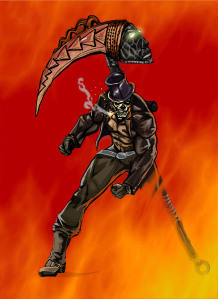 On Valentine’s Day weekend 2014 Dieselfunk was brought officially to the world amid much fanfare, bringing a new element to the Retrofuturist spectrum, much as Steamfunk had before.
On Valentine’s Day weekend 2014 Dieselfunk was brought officially to the world amid much fanfare, bringing a new element to the Retrofuturist spectrum, much as Steamfunk had before.
Yet this unveiling was not without controversy, as anyone who reads this blog is well aware. Accusations of “racism” were made by a couple of prominent names in the Dieselpunk community, and arguments began on what *funk’s role was within the Retrofuturist movement and culture. Looking on the surface one might be led to believe that *punk and *funk were opposed, mutually antagonistic communities. But is this true?
To answer this, let us look at the Dieselpunk community itself, who we are, and what the Dieselpunks (and Steampunks) think of their Afrofuturist brothers and sisters.
First, who are the Dieselpunks? Just a bunch of suburban white guys dressing up like Nazis?
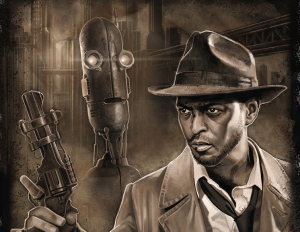 Au contraire, mon ami. Dieselpunk is a diverse, international community. The global Dieselpunk community has members on every continent save Antarctica (and who knows if one of the polar scientists living there isn’t sporting a fedora between studies?) with major centers of Dieselpunk activity in Argentina, Australia, China, France, Germany, Great Britain, Israel, Italy, Japan, Mexico, New Zealand, Russia, and the United States, to name a few. The Dieselpunks themselves are ethnically, racially, culturally, religiously, gender, and politically diverse and we pride ourselves on our devotion to diversity and equality. We don’t shy away from the wrongs of the Diesel Era or try to whitewash them. To the contrary, the “Punk” side of it is very much grounded in its original meaning of the outsider, the outcast, the voice not heard under the meta-narrative. In this way Dieselfunk is a natural extension of that Punk attitude and commitment.
Au contraire, mon ami. Dieselpunk is a diverse, international community. The global Dieselpunk community has members on every continent save Antarctica (and who knows if one of the polar scientists living there isn’t sporting a fedora between studies?) with major centers of Dieselpunk activity in Argentina, Australia, China, France, Germany, Great Britain, Israel, Italy, Japan, Mexico, New Zealand, Russia, and the United States, to name a few. The Dieselpunks themselves are ethnically, racially, culturally, religiously, gender, and politically diverse and we pride ourselves on our devotion to diversity and equality. We don’t shy away from the wrongs of the Diesel Era or try to whitewash them. To the contrary, the “Punk” side of it is very much grounded in its original meaning of the outsider, the outcast, the voice not heard under the meta-narrative. In this way Dieselfunk is a natural extension of that Punk attitude and commitment.
So what do the Punks think of the Funkateers? Obviously some have spoken out in the negative, but fish below the surface and you find a very receptive community.
A poll asking the (weighted and leading) question of if a subgenre devoted to “empowering a specific race” should be considered “racist” was running continuously towards “no” with at least a plurality up to a supermajority at times, until its premature demise due to vote hacking. The associated comments to that poll were overwhelmingly positive towards and open to the Funk.
Let’s take a comment from Sky Marshal Jonny B. Goode, a prominent member, promoter, and leader within the Southern California Steampunk and Dieselpunk culture and a high ranking member of the Army of Toy Soldiers. A man whose word carries a lot of weight in the Diesel- and Steampunk cultures:
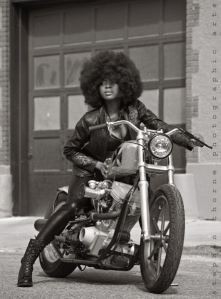 “I actually like the fresh air that steamfunk brings into steampunk. I think it’s cool to see 1890s and 1970s all mixed up. Very creative. And I’ve always been a fan of funk music. Also, keep in mind that in the real Victorian age, minorities were very poorly treated. If we’re going to rewrite that era in our own style, let’s have a better showing for the minorities this time around.”
“I actually like the fresh air that steamfunk brings into steampunk. I think it’s cool to see 1890s and 1970s all mixed up. Very creative. And I’ve always been a fan of funk music. Also, keep in mind that in the real Victorian age, minorities were very poorly treated. If we’re going to rewrite that era in our own style, let’s have a better showing for the minorities this time around.”
Another telling comment came from Steam- and Dieselpunk Thomas E. Delfi, who said:
“Most Steamfunk and Dieselfunk I’ve read and seen isn’t about empowerment, it’s about presence. Steampunk and Dieselpunk has been accused of being an exclusive because of the perceived lack of minorities at events and in literature that suffered during the Victorian Period, which isn’t a fair assumption. That’s me speaking as the Puerto Rican with a Dieselpunk Rough Rider Costume.
“So, someone coins the term Steamfunk to highlight something different, a new perspective, not to specifically empower or segregate. To me, the term Steamfunk has been adopted because there’s so much written material by Steampunks that stories featuring black or Latino leads can be lost and the assumption that we are an exclusive, Anglo-philic genre will continue. If anything, Steamfunk and Dieselfunk is trying to prove Steampunk is an inclusive culture.”
He later added specifically for this blog entry: “I didn’t come into the Steampunk community to make points or represent beliefs. I came here for the same reason many people do; I wanted to have fun. I wanted to enjoy myself in the company of the eccentric, the creative, and the wide eyed maniacs that make up this wonderful community. So to me it’s not about under representation or making a stance. To me, anything that is Steampunk derived, be that Dieselpunk, Dieselfunk, or Steamfunk, must be conducive to fun and enjoyment. If we entertain a new perspective or outlook along the way, all the better. But I and many others didn’t come to this community and this fantasy to divide it. So in short, let’s just have fun.”
These voices were far from alone, as prominent Dieselpunks came out in loud support of Dieselfunk. In Episode 38 of the Diesel Powered Podcast, the premier radio outlet of the Dieselpunk community, hosts Johnny “Big Daddy Cool” Dellaroca, Larry Aymett, Ava Dahl, and John Wofford defended Dieselfunk and Steamfunk, rejecting any claims of “racism” in *Funk as misguided and ignorant, and openly welcoming *Funk into the Retrofuture community [http://bigdaddycoolshows.podomatic.com/entry/2014-02-10T12_02_24-08_00].
And Larry Aymett, a man so central to the Dieselpunk culture, its promotion, and its philosophical foundations that he was declared the “Dieselpope”, went even further in a special message for this blog entry:
“Dieselpunk needs dieselfunk because of the way it explores the African-American experience during the 1920s – 40s. This exploration is vital for the –punk suffix in dieselpunk always points to the outsider. The ‘punk’ is the one marginalized by society. I’m grateful for the existence of dieselfunk and the way it uses Afrofuturism to explore the issues of race and class.”
In short, it is obvious: Punks want the Funk!
We see what you’re doing here and we love it. We want more of it. Our punk roots demand that the unheard voices be heard and that the oppressed be given the chance to stand up for themselves. Steamfunk and Dieselfunk are the epitome of that Punk attitude. Nothing could be less punk in my mind than to think otherwise.
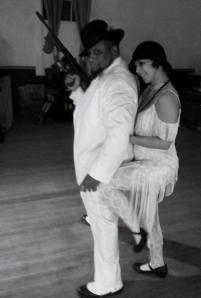
Cosplayers / Makers / Designers, Mark & Theresa Curtis.
African American contributions in the Diesel era aren’t just “worth including”, they’re central to the Dieselpunk narrative: the Harlem Renaissance, the birth and spread of Jazz and Blues, the struggles of right-thinking folk against the growing, hateful tyranny of Jim Crow, the KKK, or the NSDAP. What is the Diesel Era without Josephine Baker, Louis Armstrong, Zora Neale Hurston, Cab Calloway, Langston Hughes, Jack Johnson, Eugene Bullard, or Bessie Coleman (to name but a fraction)? These are more than “just” the African American voices of the era, they are some of the essential voices of the era. Without the African voice…or the Asian voice, the Latin voice, the woman’s voice, the homosexual voice…there is no Diesel era. What is the era without the struggles of the Nisei or the Mexican American “zoot suiter” punks in California, or without the belle epoch of Rio de Jainero, or without the “we can do it” attitude of Rosie the Riveter or the artistic achievements of Cole Porter? That such voices are not always obviously present in Dieselpunk is more than just an omission, it is a heartfelt loss.
So to deny a place for Dieselfunk is to deny a critical part of what made the Diesel Era the time we Dieselpunks love, and is to deny a critical, essential part of what Dieselpunk is.
So please allow me the honor of being the Dieselpunk to formally welcome you, the Funkateers, into the Retrofuturist society.
Respectfully,
Jack “Cap’n Tony” Philpott…
Jack Philpott is a born writer and artist who somehow ended up as an Electrical Engineer. Whether he’s enjoying a chilled Vermouth on the streets of Geneva, being catapault-launched off of a perfectly good aircraft carrier, or digging in the sand box with his son, Jack tries to appreciate the sublime nature of the moment.


February 19, 2014
Steampunk, Dieselpunk and Stereotype Threats at Anachrocon!
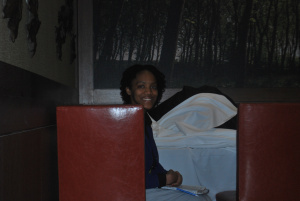 My wife; my seventeen year-old daughter, Yetunde; my eleven year-old, son, Oluade; and my five year-old daughter, Oriyemi, recently participated in Anachrocon 2014.
My wife; my seventeen year-old daughter, Yetunde; my eleven year-old, son, Oluade; and my five year-old daughter, Oriyemi, recently participated in Anachrocon 2014.
Yetunde put tremendous thought into her cosplay. She is a stickler for historical accuracy, so she insisted everything from her shoes, to her hairstyle to her fingernails be done as they would have been during the 1940s; to achieve said accuracy, Yetunde devoted weeks of research to the aesthetics of the 1940s. She did this while maintaining the 4.0 grade-point average she has achieved for her entire academic career.
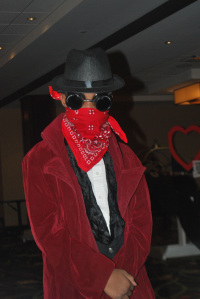 Oluade gave a lot of thought to his cosplay as well. Since this year’s theme for Anachrocon was Dieselpunk, which is set in the Diesel Era of the 1920s through the end of WWII, and he knew, through reading my blogs and my latest novel, The Scythe, that Pulp magazines were popular during most of that era, Oluade decided he wanted to be a two-fisted masked pulp hero. Thus, the Auburn Avenger was born!
Oluade gave a lot of thought to his cosplay as well. Since this year’s theme for Anachrocon was Dieselpunk, which is set in the Diesel Era of the 1920s through the end of WWII, and he knew, through reading my blogs and my latest novel, The Scythe, that Pulp magazines were popular during most of that era, Oluade decided he wanted to be a two-fisted masked pulp hero. Thus, the Auburn Avenger was born!
His concept of the character is so well-developed and so cool, I have promised Oluade that the Auburn Avenger will feature in a few of my short stories and perhaps even a Middle Grade novella.
 Oriyemi was happy to just cosplay a vampire princess and to joyously – and accurately – point out which costumes at Anachrocon were Steampunk and Dieselpunk.
Oriyemi was happy to just cosplay a vampire princess and to joyously – and accurately – point out which costumes at Anachrocon were Steampunk and Dieselpunk.
My children were completely comfortable at Anachrocon; much more than I have ever been at any convention.
Why?
Because they do not suffer from stereotype threat.
“What is stereotype threat,” you ask?
It is the fear or anxiety of confirming some negative stereotype about your social group; it is the idea that we hold within us that we might accidentally act in ways that confirm stereotypes about ourselves.
These fears are often self-fulfilling, pulling us, like magnets, toward the very stereotypical actions we hope to avoid.
In the Yoruba culture, we call this phenomenon Elenini – the personification of negativity. In western societies the statement “As a man thinketh in his heart, so is he,” applies.
I have blogged about how the media often portrays Black people and other People of Color, negatively. One of the implications of these negative images is the notion of stereotype threat. A person who is constantly bombarded with negative images of his or her racial or ethnic group, begins to internalize the same social and personal characteristics of these images.
Numerous psychological studies have examined effects of stereotype threat in areas such as standardized tests, and athletic performance.
For example, the commonly held assumption that women are less skilled in mathematics than men has been shown to affect the performance of women on standardized math tests. When women were primed beforehand of this negative stereotype, scores were significantly lower than if the women were led to believe the tests did not reflect these stereotypes.
Channels such as BET and MTV offer blatantly stereotypical images of Black people and of women of all races that greatly affect young viewers who take these images to heart.
The term stereotype threat was first used by psychologists Claude Steele and Joshua Aronson, who, in 1995, conducted several experiments that proved Black college freshmen and sophomores performed more poorly on standardized tests than White students when their race was emphasized. When race was not emphasized, however, Black students performed better and equivalently with White students.
The results showed that performance in academic contexts can be harmed by the awareness that one’s behavior might be viewed through the lens of racial stereotypes.
Long-term effects of stereotype threat are shown to contribute to educational and social inequality and affect stereotyped individuals’ performance in a number of domains beyond academics.
Research shows that stereotype threat can harm the academic performance of any individual for whom the situation invokes a stereotype-based expectation of poor performance. For example, stereotype threat has been shown to harm the academic performance of Hispanics, students from low socioeconomic backgrounds, girls and women in math, and even white males when faced with the stereotype of Asian superiority in math.
Stereotype threat produces numerous consequences, most of which are negative in nature, such as:
1. Decreased performance
Perhaps the most widely known consequence of stereotype threat is reduced achievement on tests in situations in which the stereotype is relevant. In addition to affecting test performance, stereotype threat has been shown to decrease performance on other kinds of tasks, as varied as white people and women of all races in athletics ; women in negotiation; the elderly in memory performance and women in driving. Stereotype threat, it appears, can harm performance on any task where a stereotype is invoked suggesting that members of some groups will perform more poorly than others.
2. Internal Attributions for Failure
We often try to identify what factors are responsible when we fail to achieve a desired outcome. More often than not, we blame this failure on internal factors; on ourselves. This is especially true for those under stereotype threat. A test in 2008 showed that women under stereotype threat were more likely than men to attribute their failure on a computer task to their internal characteristics. When failure is internalized, stereotypes are reinforced.
3. Self-handicapping
Self-handicapping is a defensive strategy in which individuals erect barriers to their own performance to provide something to blame for their failure. They can point fingers at the barriers rather than at any deficiencies in their ability or effort. A test in 2002 showed that girls who performed poorly on a math test under stereotype threat were more likely to blame that performance on stress they experienced before taking the test.
4. Discounting the task
People under stereotype threat often question the validity of a task or the importance of the trait being tested. You might view a task as biased or as being ill-equipped to test your abilities if you expect to struggle with the task or have struggled with it in the past.
I believe this is one of the main reasons many Black people do not cosplay or read speculative fiction, whether it is written by a Black person or not. We are stereotyped as not being into Science Fiction and Fantasy; not possessing the capacity to create, or even understand it. Thus, we say such stuff is for white folks, or that Black people are too busy dealing with reality to deal with escapist hobbies such as reading Science Fiction or engaging in cosplay.
5. Distancing yourself from the stereotyped group
Stereotype threat can also affect the degree that we allow ourselves to enjoy and identify with activities associated with our social group. Steele and Aronson discovered that Black people who experienced stereotype threat expressed weaker preferences for – and performed less well than their White counterparts in – stereotypically “Black” activities such as jazz, hip-hop, and basketball. This identity distancing reflects a desire not to be seen through the lens of a racial stereotype.
To preserve their identity as a competent person in certain circles, stereotyped individuals sometimes distance themselves from an aspect of their social identity, or from people that bear the burden of the negative stereotype. When I first began to push Steamfunk, some Black Steampunks distanced themselves from me for fear that I was going to be the stereotypical angry Black man who happened to infiltrate Steampunk.
The effects of stereotype threat can be reduced or eliminated by several means.
1. Reframing the task
To reduce stereotype threat, you can “reframe” the task – use a different language to describe it. Simply informing Black people that it is cool to cosplay and showing examples of it can alleviate stereotype threat in fandom.
2. Deemphasizing threatened social identities
Interventions that encourage individuals to consider themselves as complex and multi-faceted can reduce vulnerability to stereotype threat.
It is important for Black people to know that we are not monolithic and thus are not confined to some unimaginative, non-creative, non-expressive “Black box.”
3. Encouraging self-affirmation
Affirming your self-worth is an effective means for protecting yourself from stereotype threat and the resulting failure.
Encourage people to think about their important characteristics, skills, values and roles. Black people who are given the opportunity to affirm their commitment to being Steamfunkateers are less likely to respond in a stereotypical fashion and bring great originality, creativity and coolness to Steampunk.
4. Providing role models
Providing role models who demonstrate proficiency in a field can reduce or even eliminate stereotype threat effects.
A Black historian sat in on the Diversity in Steampunk and Alternate History panel that I and the Co-Editor of the Steamfunk anthology, Milton Davis, were panelists on. He said that his interest in Steampunk came through his introduction to it through my blogs about Steamfunk and later, through reading the anthology. He further stated that he would have never participated in Anachrocon, or any other fandom convention, for that matter, if not for my – and Milton Davis’ – work.
In my efforts to help make all eight of my children proud of their Blackness; their intelligence; their wit and their creativity, I have, fortunately, helped to alleviate and maybe even eliminate any stereotype threat they may have been under had I done otherwise.
They have always seen my pride; they have seen me live as an African traditionalist in non-traditional America; they have always seen me embrace my creativity; to admire and model the brilliant and the ingenious; to push myself just as much as I push them and to succeed because of it.
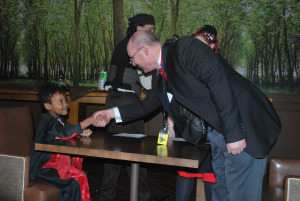
Oriyemi engaging in her first National Tea Duel.
So Yetunde, Oluade and Oriyemi approached Anachrocon with no fears, no worry that they would fall into some stereotype and embarrass themselves, me, or Black people. They weren’t thinking of being Black; they simply were Black, thus at Anachrocon, like everywhere else, they shined.
I pray to be like them one day when I grow up.


February 13, 2014
ARE STEAMFUNK, DIESELFUNK and SWORD & SOUL NECESSARY? Countering Negative Images of Black People in Science Fiction and Fantasy
Countering Negative Images of Black People in Science Fiction and Fantasy
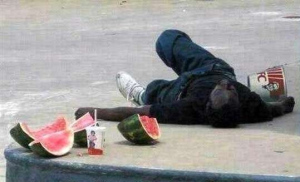 Images and words combined are very powerful, and have been used, quite effectively, to convey this whole idea of Black people being “less than”; “not as good as”: the myth of Black inferiority.
Images and words combined are very powerful, and have been used, quite effectively, to convey this whole idea of Black people being “less than”; “not as good as”: the myth of Black inferiority.
We have become so insensitive or desensitized to our own negative typecasting and even dehumanization that we are no longer conscious of what we see, hear and what is going into our minds. We have become a party to our own brainwashing. We have joined in and become our own victimizers.
In the old days, white comedians put on black cork and made a living humiliating and ridiculing Black people. A few years later, their senses dulled by this illusion called “progress”, Black comedians said to the white comedians “Hey, you don’t have to ridicule and humiliate us, we’ll do it. We’ll take it from here, boss.”
And they took it from there…and carried it straight to Hell.
Let’s take the use of the word “nigger”, for example; so talked about now because of its use 110 times in the movie Django Unchained. Black comedians took this wicked, destructive word and took ownership of it as if to call ourselves a nigger was empowering, as if it was a term of endearment and still vehemently defend its use to this very day. And no, saying “the N-word” is no better. It is just foolish and strangely, makes us even less human than our use of nigger does.
“Man, you my N-Word!”
Or Kanye West and Jay-Z’s popular Niggas In Paris, now the politically correct N-Words In Paris:
“What’s Gucci my N-Word?
What’s Louis my killa?
What’s drugs my deala?
What’s that jacket, Margiela?
Doctors say I’m the illest
Cause I’m suffering from realness
Got my N-Words in Paris
And they goin’ gorillas, heh?”
Yeah…that shit cray.
The historian Carter G. Woodson said that Black people have been conditioned to go around to the back door, and if there is no back door, we will insist on one.
 If you can get a Black comedian to show up on a late-night talk show and act the clown, it’s comforting to those people who say, “See they are a happy people. They aren’t angry with us for five hundred years of slavery and oppression.” It is like approaching a dog you have abused, neglected and chained up in your kitchen for a week, thinking “Boy, I sure hope it doesn’t bite.” And if, instead of tearing out your throat, the dog starts wagging its tail, you breathe a sigh of relief and say “Whew, good dog.”
If you can get a Black comedian to show up on a late-night talk show and act the clown, it’s comforting to those people who say, “See they are a happy people. They aren’t angry with us for five hundred years of slavery and oppression.” It is like approaching a dog you have abused, neglected and chained up in your kitchen for a week, thinking “Boy, I sure hope it doesn’t bite.” And if, instead of tearing out your throat, the dog starts wagging its tail, you breathe a sigh of relief and say “Whew, good dog.”
We have been conditioned to expect little of ourselves and of each other.
Many Black authors lament that they create great content, but Black people pass by their table at geek conventions and head straight to Jim Butcher’s table to purchase his Dresden Files novels, or to the Marvel Comics booth to pick up the latest X-Man graphic novel.
Don’t lament, Black author. Remember, we have been conditioned to expect little of ourselves and of each other, so most Black people will assume, without any evidence, that your work is wack. You have to reach out and educate them; show them that your work is just as good as – or better than, what they are used to. Most will still flock to the Marvel booth. They love – and have faith in – good ol’ Stan Lee. To chastise them for that will gain you enemies, not friends and certainly not fans.
Now, outside the Black geek community is where I have found my greatest support. There is a hunger among “regular” Black people – those who do not identify as geeks, nerds, or science fiction fans – for speculative fiction written by and about Black people.
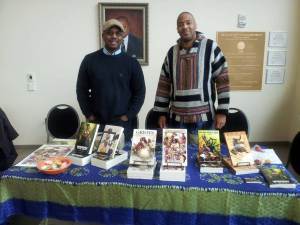 At the Westview Festival last year – a neighborhood festival in the predominantly Black, lower-to-middle-class area near Atlanta’s West End – I sold out all of my books in less than a half hour. Mind you, my table was next to a table that sold – at less than half price – mainstream fiction and science fiction and fantasy by authors such as Isaac Asimov, J.R.R. Tolkien, Frank Herbert and George R.R. Martin.
At the Westview Festival last year – a neighborhood festival in the predominantly Black, lower-to-middle-class area near Atlanta’s West End – I sold out all of my books in less than a half hour. Mind you, my table was next to a table that sold – at less than half price – mainstream fiction and science fiction and fantasy by authors such as Isaac Asimov, J.R.R. Tolkien, Frank Herbert and George R.R. Martin.
At the recent 3rd Annual Ujamaafest – a festival celebrating Kwanzaa’s principle of Collective Economics – Milton Davis and I shared a table. Once again, Black Speculative Fiction sold like hotcakes. At this festival, the participants were mainly culturally conscious Black people from all walks of life.
At both festivals, most of the people who purchased books said that if Black authors were writing Science Fiction and Fantasy, with Black heroes, when they were young, they would have been into it, but they were eager to get their children and grandchildren into Black Speculative Fiction.
Are Steamfunk, Dieselfunk, Sword & Soul and other Black Speculative Fiction necessary? Damn right, they are.
While many of us want to see ourselves as the heroes and sheroes and recognize the need for Black Speculative Fiction, many of us cannot fathom ourselves as star-spanning, evil-crushing, saving-the-world heroes. The horse wrangler for the Steamfunk feature film Rite of Passage told me he never imagined we could be the heroes in a Fantasy or Science Fiction story, or that such a movie would ever be created.
The media is directly responsible for this. The perpetuation of stereotypes is always done through print, television, film, radio, music and, now, the internet.
Flip the channel or turn the page and there are the “baby mamas” and “baby daddies” so ubiquitous in common American culture that they become plot points or titles for mainstream comedies and movies.
The syndicated television program Maury, hosted by Maury Povich, is known for its “Who’s Your Daddy?” segments. Much of the content is based on issuing paternity tests to teens and young adults in hopes of determining fatherhood.
Many of Maury’s guests are Black, and the sheer number of these cases is damning. Shows like these, along with court television shows that promote the same dysfunction, are very popular.
Even Black millionaire housewives, doctors and business moguls are portrayed as argumentative, catty, incapable of being unified and downright ig’nant.
Millions of viewers are indoctrinated by these images of Black family chaos. And we watch these programs like a gory highway car wreck because they involve so many people who look like us.
And we accept and share these perceptions without question, qualm or quarrel.
At a very young age, Black men and women are inundated with messages that they cannot trust or depend upon one other. Children see images of – and hear comments and jokes about – lazy, greedy, irresponsible, or otherwise flawed Black adults.
Black characters have appeared in American films since the beginning of the industry in 1888, but Black actors were not even hired to portray Black people in early works. Instead, white actors and actresses were hired to portray the characters while in “blackface.”
In addition, Black people have, for nearly a hundred years, been purposely portrayed in films with negative stereotypes that reinforce white supremacy over us. Since motion pictures have had more of an impact on the public mind than any other entertainment medium in the last ninety years, this has had a tremendous effect on society’s view of Black people.
 The media sets the tone for the morals, values, and images of our culture. Many people in this country believe that the degrading stereotypes of Black people are based on reality and not fiction. Everything they believe about us is determined by what they see on television. After over a century of movie making, these horrible stereotypes continue to plague us today, and until negative images of Black people are extinguished from the media, we will be regarded as second-class citizens and will regard ourselves as such.
The media sets the tone for the morals, values, and images of our culture. Many people in this country believe that the degrading stereotypes of Black people are based on reality and not fiction. Everything they believe about us is determined by what they see on television. After over a century of movie making, these horrible stereotypes continue to plague us today, and until negative images of Black people are extinguished from the media, we will be regarded as second-class citizens and will regard ourselves as such.
We have not come that far since 1914, when Sam Lucas was the first black actor to have a lead role in a movie for his performance in Uncle Tom’s Cabin.
1915 is a significant date in motion picture history because D.W. Griffith released The Birth of a Nation, which supported the Ku Klux Klan and is possibly the most anti-Black film ever made.
The Birth of a Nation – with its vicious portrayal of Black people as subhuman compared to the glorified Ku Klux Klan – was important because it led to the creation of a new industry that produced “race films” for Black People. These films portrayed us in a positive light and addressed many social concerns of the community.
Before “race films,” Black people in films were nothing more than shuffling, shiny-faced, head-scratching simpletons with bugged out eyes who leaned on brooms and spoke bad English, but after the introduction of “race films,” we were depicted with more dignity and respect.
In order for Black people to ensure that they would have positive roles and stop reinforcing negative stereotypes through film, we had to make our own movies. The same holds true today.
I am asked, quite often, if there is such a thing as a Black Science Fiction movie. Supposing by “Black Science Fiction movie”, they mean a science fiction or fantasy movie that features a Black protagonist and majority Black cast and deals with issues that strongly impact Black people, I tell them that Black Science Fiction movies began in 1939, with the release of Son of Ingagi and that filmmakers continue to make quality Black Science Fiction movies today.
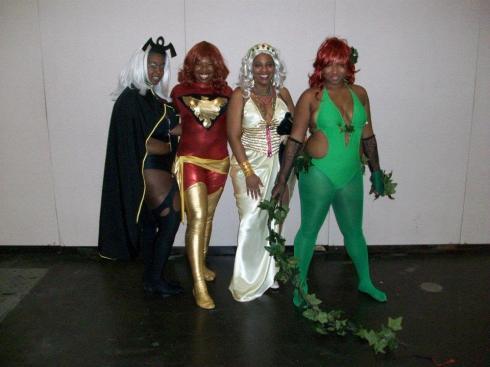 We learn a great deal about human nature by comparing ourselves to others; and by comparing ourselves to fictional heroes…and villains.
We learn a great deal about human nature by comparing ourselves to others; and by comparing ourselves to fictional heroes…and villains.
Contemplating fictional characters helps us examine the nature of heroism and villainy. Through fiction, film and television, we develop our view of the ideal person; we learn what to expect from good guys and bad guys, even in real life.
What distinguishes a superhero from a supervillain? How do their basic personalities differ — and how has the media affected our perception of ourselves and heroism?
Most people see themselves as being close in personality to their favorite superheroes and mimic their heroes’ characteristics in an effort to live up to that perception.
However, if the fiction you read or see consistently portrays those who look like you as less than heroic; as savage – whether noble, or not – as the eternal sidekick; as the first to die; as the one to sacrifice him or herself so that the real heroes can save the world; as the thug; the pimp; the whore, then how do you see yourself?
In Blueprint for Negro Literature, Richard Wright discussed the problem of Black literature:
“They [Black authors] entered the Court of American Public Opinion dressed in the knee-pants of servility, curtsying to show that the Negro was not inferior, that he was human, and that he had a life comparable to that of other people. These were received as poodle dogs, who have learned clever tricks. … In short, Negro writing on the whole has been the voice of the educated Negro pleading with white America.”
Wright went on to say that every story Black people write “should carry within its lines, implied or explicit, a sense of the oppression of the Negro people, the danger of war, of fascism, of the threatened destruction of culture and civilization; and, too, the faith and necessity to build a new world.”
While such pleading – such “curtsying to show that we are not inferior” – may have been the goal of Black writers during Wright’s time, it is certainly not my goal or the goal of my colleagues.
On the contrary, I seek to show Black people, in general – teens and tweens, in particular – that we are not inferior; that we are heroic; that we are beautiful, courageous, brilliant and strong.
Furthermore, while I appreciate a good story that deals with the ills of racism, sexism, classism and the destruction and rebuilding of Black civilization, I do not feel that every story must, or even should, deal with such issues.
 What I do feel Black Speculative Fiction should do is tell our stories, because they have gone untold in Speculative fiction for so damned long. And I feel those stories should feature Black heroes and an occasional Black villain, too…a criminal mastermind, that is; not a damned street thug, or other walking stereotype.
What I do feel Black Speculative Fiction should do is tell our stories, because they have gone untold in Speculative fiction for so damned long. And I feel those stories should feature Black heroes and an occasional Black villain, too…a criminal mastermind, that is; not a damned street thug, or other walking stereotype.
And please, no more Black heroes who begin as gangsters, prostitutes, drug dealers, or dope fiends. Thanks.
If you are seeking a list of works of great Black Speculative Fiction, check it out here. For a list of great Black authors of Speculative Fiction, you can find that here. For a list of Black Speculative events in Atlanta in celebration of Black History Month, look here.
So, do you feel Steamfunk, Dieselfunk and Sword & Soul are necessary? Is there a type of Black Speculative Fiction you’d like to see created or more of? Horror? Dystopian? Young Adult glittery vampires?
Comment and let your opinion be known!


February 11, 2014
TOP 20 STEAMFUNK, DIESELFUNK, SWORD & SOUL AND URBAN FANTASY BOOKS FOR BLACK YOUTH!
Recently, I wrote about why Black children should read and write Science Fiction and Fantasy. I also wrote about it here. Now I would like to provide you with a list of books for young adults, teens and tweens. A list of books for children aged 2-9 will follow in a later blog.
Young Adult (“YA”) Fiction is fiction marketed to adolescents and young adults, ranging roughly between the ages of 14 to 21. The majority of YA stories portray an adolescent as the protagonist, rather than an adult or a child. The subject matter and story lines are typically consistent with the age and experience of the main character and the stories span the entire spectrum of fiction genres.
Middle Grade (“MG”) Fiction is intended for readers between the ages of 8 to 12, with the protagonist at the higher end of the age range.
MG readers are learning about who they are, what they think, and where they fit in. Their focus is inward and the conflicts in MG books usually reflect this. The themes range from school situations, friendships, relationships with peers and siblings, and daily difficulties that may seem ordinary to the rest of us. The protagonist’s parents are usually seen and have some sort of an influence. Stories are usually fast paced and chapters are short.
In contrast, Young Adult novels deal with underlying themes and more complicated plots. They allow teen readers to examine deeper issues, their roles in life, the importance of relationships, how to cope with adversity and even tragedy and how their actions can impact the world.
YA protagonists are usually searching for their identity, figuring out who they are as an individual and where they fit in. YA books are generally much more gritty and realistic than MG books. Parents have less influence in YA stories and are often not seen at all.
Below is a list of twenty of the most Blacktastic books that are sure to entertain, educate and even empower readers, young and old.
The books are grouped into three categories, by age appropriateness, for your convenience.
While there are many more great books written by and about Black people, this is a good start and more books will be shared in future posts.
YOUNG ADULT (Ages 15+)
A Single Link, by Balogun Ojetade
After suffering a brutal rape at the hands of a martial arts champion, Remi “Ray” Swan decides that, to gain closure and empowerment, she must face her attacker in the first professional fight between a man and a woman.
Join Ray in this powerful, two-fisted adventure as she fights, not just for herself, but for all who have suffered at the cruel hands of those who would wreak pain, oppression, injustice and death!
Step into the cage, where action, adventure, bone shattering fights, and a touch of romance await you!
Damballa, by Charles R. Saunders
The first ever African American 1930s avenger sets out to stop a Nazi plot to subvert a championship fight.
From deepest Africa to the streets of 1930s Harlem, the action is none stop.
Written by famed novelist Charles Saunders, with interior illustrations by Clayton Hinkle and a cover by Charles Fetherolf, this is a history making pulp adventure fans do not want to miss.
Devil’s Wake, by Steven Barnes and Tananarive Due
 What happens when an unprecedented infection sweeps the world, leaving the earth on the brink of the Apocalypse?
What happens when an unprecedented infection sweeps the world, leaving the earth on the brink of the Apocalypse?
But this infection goes far beyond disease. Beyond even the nightmare images of walking dead or flesh-eating ghouls. The infected are turning into creatures unlike anything ever dreamed of . . . more complex, more mysterious, and more deadly.
Trapped in the northwestern United States as winter begins to fall, Terry and Kendra have only one choice: they and their friends must cross a thousand miles of no-man’s-land in a rickety school bus, battling ravenous hordes, human raiders, and their own fears.
In the midst of apocalypse, they find something no one could have anticipated . . . love.
Dillon and the Voice of Odin, by Derrick Ferguson
He’s a soldier of fortune gifted with an astonishing range of remarkable talents and skills that make him respected and feared in the secret world of mercenaries, spies and adventurers. A world inhabited by amazing men and women of fabulous abilities that most of us are unaware even exists.
Fueled by a taste for excitement, driven by an overpowering desire to protect the innocent, see that wrongs are righted and assisted by a worldwide network of extraordinary men and women, all experts in their fields, Dillon spans the globe in a never-ending quest for the wildest and most breathtaking adventures of all!
Griots: A Sword and Soul Anthology, Edited by Milton J. Davis and Charles R. Saunders
 Magic. Myth. Warfare. Wonder. Beauty. Bravery. Glamour. Gore. Sorcery. Sensuality. These and many more elements of fantasy await you in the pages of Griots, which brings you the latest stories of the new genre called Sword and Soul.
Magic. Myth. Warfare. Wonder. Beauty. Bravery. Glamour. Gore. Sorcery. Sensuality. These and many more elements of fantasy await you in the pages of Griots, which brings you the latest stories of the new genre called Sword and Soul.
The tales told in Griots are the annals of the Africa that was, as well as Africas that never were, may have been, or should have been. They are the legends of a continent and people emerging from shadows thrust upon them in the past. They are the sagas sung by the modern heirs of the African story-tellers known by many names – including griots.
Here, you will meet mighty warriors, seductive sorceresses, ambitious monarchs, and cunning courtesans. Here, you will journey through the vast variety of settings Africa offers, and inspires. Here, you will savor what the writings of the modern-day griots have to offer: journeys through limitless vistas of the imagination, with a touch of color and a taste of soul.
Griots: Sisters of the Spear, Edited by Milton J. Davis and Charles R. Saunders
Griots: Sisters of the Spear picks up where the ground breaking Griots Anthology leaves off.
Charles R. Saunders and Milton J. Davis present seventeen original and exciting Sword and Soul tales focusing on black women.
Just as the Griots Anthology broke ground as the first Sword and Soul Anthology, Griots: Sisters of the Spear pays homage to the spirit, bravery and compassion of women of color.
The griots have returned to sing new songs, and what wonderful songs they are!
Ki Khanga: The Anthology, Edited by Milton J. Davis and Balogun Ojetade
What is Ki Khanga?
The answer lies in the pages of this amazing anthology.
Balogun Ojetade and Milton Davis define this fascinating world which forms the foundation of the Ki Khanga Sword and Soul Role Playing Game.
Prepare yourself for stories of bravery, tragedy, love and adventure.
Prepare yourself for Ki Khanga.
Moses: The Chronicles of Harriet Tubman, by Balogun Ojetade
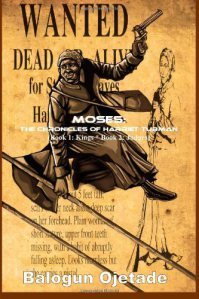 “I’m gon’ drive the evil out and send it back to Hell, where it belong!” – Harriet Tubman
“I’m gon’ drive the evil out and send it back to Hell, where it belong!” – Harriet Tubman
Harriet Tubman: Freedom fighter. Psychic. Soldier. Spy. Something…more. Much more.
In “MOSES: The Chronicles of Harriet Tubman (Book 1: Kings * Book 2: Judges)”, the author masterfully transports you to a world of wonder…of horror…of amazing inventions, captivating locales and extraordinary people.
In what is hailed as the world’s first Steamfunk novel, Harriet Tubman must match wits and power with the sardonic John Wilkes Booth and a team of hunters with powers beyond this world in order to save herself, her teenaged nephew, Ben and a little girl in her care – Margaret.
But is anyone who, or what, they seem?
Parable of the Sower, by Octavia Butler
In 2025, with the world descending into madness and anarchy, one woman begins a fateful journey toward a better future
Lauren Olamina and her family live in one of the only safe neighborhoods remaining on the outskirts of Los Angeles. Behind the walls of their defended enclave, Lauren’s father, a preacher, and a handful of other citizens try to salvage what remains of a culture that has been destroyed by drugs, disease, war, and chronic water shortages. While her father tries to lead people on the righteous path, Lauren struggles with hyperempathy, a condition that makes her extraordinarily sensitive to the pain of others.
When fire destroys their compound, Lauren’s family is killed and she is forced out into a world that is fraught with danger. With a handful of other refugees, Lauren must make her way north to safety, along the way conceiving a revolutionary idea that may mean salvation for all mankind.
Steamfunk, Edited by Balogun Ojetade and Milton J. Davis
 A witch, more machine than human, judges the character of the wicked and hands out justice in a ravaged Chicago. John Henry wields his mighty hammers in a war against machines and the undead. Frederick Douglass and Harriet Tubman rule a country of freed slaves that rivals – and often bests – England and France in power and technology.
A witch, more machine than human, judges the character of the wicked and hands out justice in a ravaged Chicago. John Henry wields his mighty hammers in a war against machines and the undead. Frederick Douglass and Harriet Tubman rule a country of freed slaves that rivals – and often bests – England and France in power and technology.
You will find all this – and much more – between the pages of Steamfunk, an anthology of incredible stories by some of today’s greatest authors of Science Fiction, Fantasy and Steamfunk – African and African American-inspired Steampunk.
Editors Milton Davis and Balogun Ojetade have put together a masterful work guaranteed to transport you to new worlds. Worlds of adventure; of terror; of war and wonder; of iron and steam. Open these pages and traverse the lumineferous aether to the world of Steamfunk!
Taurus Moon: Relic Hunter, by Keith Gaston
Taurus Moon is a relic hunter, but the artifacts he searches for aren’t found in the jungles of the Yucatan or the deserts of Egypt. His quests often take him through the grittier parts of urbanized cities where even the toughest of thugs fear to tread. Forgotten relics once thought of as only myths and legends can be found, if you know where to look, and have the guts to go searching into dark and deadly places.
Taurus Moon is hired by a vampire crime lord to locate an ancient artifact that would make the criminal a God. Even though Taurus is no fan of vampires, especially one aspiring to become a Deity, he does love money and despite his misgivings, he begins the treacherous hunt for the artifact. Things become more complicated when a rival crime lord hires a ruthless relic hunter who has no qualms about killing the competition.
YOUNG ADULT (Ages 13+)
Changa’s Safari, by Milton J. Davis
In the 15th century on the African Continent a young prince flees his homeland of Kongo, vowing to seek revenge for the murder of his father and the enslavement of his family and his people.
He triumphs over the slavery and the fighting pits of Mogadishu to become a legendary fighter and respected merchant.
From the Swahili cities of the East African Coast to the magnificent Middle Kingdom of Asia, Changa and his crew experience adventures beyond the imagination.
Changa will not rest until he has fulfilled his promise to his family and his people. The anchors are raised and the sails unfurled.
Let the safari begin!
Fist of Africa, by Balogun Ojetade
 Nigeria 2004 … Nicholas ‘New Breed’ Steed, a tough teen from the mean streets of Chicago, is sent to his mother’s homeland – a tiny village in Nigeria – to avoid trouble with the law. Unknown to Nick, the tiny village is actually a compound where some of the best fighters in the world are trained. Nick is teased, bullied and subjected to torturous training in a culture so very different from the world where he grew up.
Nigeria 2004 … Nicholas ‘New Breed’ Steed, a tough teen from the mean streets of Chicago, is sent to his mother’s homeland – a tiny village in Nigeria – to avoid trouble with the law. Unknown to Nick, the tiny village is actually a compound where some of the best fighters in the world are trained. Nick is teased, bullied and subjected to torturous training in a culture so very different from the world where he grew up.
Atlanta 2014 … After a decade of training in Nigeria, a tragedy brings Nick back to America. Believing the disaffected youth in his home town sorely need the same self-discipline and strength of character training in the African martial arts gave him, Nick opens an Academy. While the kids are disinterested in the fighting style of the cultural heritage Nick offers, they are enamored with mixed martial arts. Nick decides to enter the world of mixed martial arts to make the world aware of the effectiveness and efficiency of the martial arts of Africa.
Pursing a professional career in MMA, Nick moves to Atlanta, Georgia, where he runs into his old nemesis – Rico Stokes, the organized crime boss who once employed Nick’s father, wants Nick to replace his father in the Stokes’ protection racket. Will New Breed Steed claim the Light Heavyweight title … Or will the streets of Atlanta claim him?
Once Upon A Time In Afrika, by Balogun Ojetade
An exciting Sword and Soul tale by Balogun Ojetade, Once Upon a Time in Afrika Tells the story of a beautiful princess and her eager suitors.
Desperate to marry off his beautiful but “tomboyish” duaghter, Esuseeke, the Emperor of Oyo, consults the Oracle. The Oracle tells the Emperor Esuseeke must marry the greatest warrior in all Onile (Afrika). To determine who is the greatest warrior, the Emperor hosts a grand martial arts tournament inviting warrior from all over the continent.
Unknown to the warriors and spectators of the tournament a powerful evil is headed their way.
Will the warriors band together against this evil?
The Scythe, by Balogun Ojetade
 He has been given a second chance at life. A second chance at revenge. He is the bridge between the Quick and the Dead. He is…THE SCYTHE!
He has been given a second chance at life. A second chance at revenge. He is the bridge between the Quick and the Dead. He is…THE SCYTHE!
Out of the tragedy of the Tulsa Race Riot of 1921, a two-fisted hero rises from the grave!
Inspired by the pulp magazines of the 1930s and 1940s, a tale of action, adventure, thrills and chills await fans of Dieselpunk, die-hard pulp fans and readers who just love a gritty story that packs a mean punch.
Enter a world in which Gangsters, Flappers, vampires, robots and the Ku Klux Klan all roam the same dark back streets; a world of grit, grime and grease; a world of hardboiled gumshoe detectives and mad scientists; a world where magic and technology compete for rule over the world.
Dieselfunk has emerged in The Scythe…and the Roaring Twenties will never seem the same!
The Seedbearing Prince, by DaVaun Sanders
Dayn Ro’Halan is a farmer’s son sworn to a life of plowing on his homeworld, Shard. After finding a lost artifact called a Seed, he’s thrust into an ancient conflict between voidwalkers of the hated world Thar’Kur, and Defenders from a floating fortress called the Ring.
Dayn must become a Seedbearer and learn to use the Seed’s power to shape worlds before the entire World Belt is lost.
Woman of the Woods, by Milton J. Davis
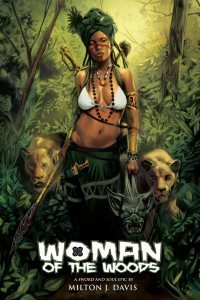 The latest Sword and Soul novel by Milton Davis returns to the land of Meji, the amazing world of Uhuru. It tells the story of Sadatina, a girl on the brink of becoming a woman living with her family in Adamusola, the land beyond the Old Men Mountains. But tragic events transpire that change her life forever, revealing a hidden past that leads her into the midst of a war between her people and those that would see them destroyed, the Mosele.
The latest Sword and Soul novel by Milton Davis returns to the land of Meji, the amazing world of Uhuru. It tells the story of Sadatina, a girl on the brink of becoming a woman living with her family in Adamusola, the land beyond the Old Men Mountains. But tragic events transpire that change her life forever, revealing a hidden past that leads her into the midst of a war between her people and those that would see them destroyed, the Mosele.
Armed with a spiritual weapon and her feline ‘sisters,’ Sadatina becomes a Shosa, a warrior trained to fight the terrible nyokas, demon-like creatures that aid the Mosele in their war against her people.
Woman of the Woods is an action filled, emotionally charged adventure that expands the scope of the world of Uhuru and introduces another unforgettable character to its heroic legends.
MIDDLE GRADE (Ages 10+)
Akata Witch, by Nnedi Okorafor
Twelve-year-old Sunny lives in Nigeria, but she was born American. Her features are African, but she’s albino. She’s a terrific athlete, but can’t go out into the sun to play soccer.
There seems to be no place where she fits. And then she discovers something amazing-she is a “free agent,” with latent magical power. Soon she’s part of a quartet of magic students, studying the visible and invisible, learning to change reality.
But will it be enough to help them when they are asked to catch a career criminal who knows magic too?
Amber and the Hidden City, by Milton J. Davis
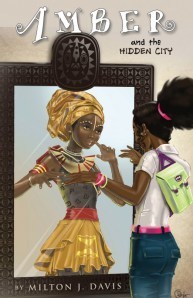 Thirteen year old Amber Robinson’s life is full of changes. Her parents are sending her to a private school away from her friends, and high school looms before her. But little does she know that her biggest change awaits in a mysterious city hidden from the world for a thousand years.
Thirteen year old Amber Robinson’s life is full of changes. Her parents are sending her to a private school away from her friends, and high school looms before her. But little does she know that her biggest change awaits in a mysterious city hidden from the world for a thousand years.
Why?
Amber’s grandmother is a princess from this magical kingdom of Marai. She’s been summoned home to use her special abilities to select the new king but she no longer has the gift, and her daughter was never trained for the task. That leaves only one person with the ability to save the city: Amber! But there are those who are determined that Amber never reaches Marai and they will do anything to stop her.
Prepare yourself for an exciting adventure that spans from the Atlanta suburbs to the grasslands of Mali.
It’s a story of a girl who discovers her hidden abilities and heritage in a way that surprises and entertains.
Interlopers: A Shifters Novel, by L.M. Davis
Make sure to clean up your messes.
Keep the cat in the house.
Fraternal twins Nate and Larissa Pantera know all about strange rules. They’ve grown up with plenty of them, and they have always obeyed those rules without question
However, disturbing things are starting to happen–both at home and at school. And when their parents go missing and a strange messenger appears, they discover that the only way to save them is by breaking all the rules.
Interlopers: A Shifters Novel is the thrilling fantasy adventure. Fans of YA fantasy, such as Harry Potter and Percy Jackson, love this new series about the Pantera twins, who discover that everything they thought they knew is only the beginning of the truth.
I am sure this list will get you well on your way on your Blacknificent journey through the world of Black Speculative Fiction. We end this with a few book trailers to take along as companions on this journey. Enjoy!


February 7, 2014
BLACK SPECULATIVE FICTION DURING THESE 28 DAYS OF BLACK HISTORY
BLACK SPECULATIVE FICTION DURING THESE 28 DAYS OF BLACK HISTORY
Every year around this time, things get very busy for me and for most of my other Black friends who create speculative works. This year is no different and many fun and exciting things are happening during Black History Month that I am proud to be involved in and that I know you will enjoy.
I’d like to share them with you and I would like for you to commit to attending at least one, if you are able to, or to shout them out all over social media if you are not; if you are attending one or more of these Blacknificent events, then please, shout ‘em out anyway.
Anachrocon

 As you probably know, my books, The Scythe and Fist of Africa dropped this month and are now available. However, the official debut of The Scythe is at Anachrocon. This is fitting because Anachrocon’s theme this year is Dieselpunk and The Scythe is a Dieselfunk Pulp novel.
As you probably know, my books, The Scythe and Fist of Africa dropped this month and are now available. However, the official debut of The Scythe is at Anachrocon. This is fitting because Anachrocon’s theme this year is Dieselpunk and The Scythe is a Dieselfunk Pulp novel.
My publishing / film production company, Roaring Lions Productions, will have a table there, with all of our books. Please, come by, purchase some great Steamfunk, Urban Fantasy or Dieselfunk, get a book signed, or just chat it up. No debating if Steamfunk or Dieselfunk is racist or separatist, though. Save that for the panel discussions I am participating in…or go to author Milton Davis with it; his table will be right beside mine. Just kidding, Milton!
Anachrocon happens February 14-16.
WREK Sci Fi Lab
On Thursday, February 20, from 7:00pm-8:00pm, Milton Davis and I will be guests on the WREK Sci Fi Lab Radio Show.
During the show, we will discuss Steamfunk, Dieselfunk and the soon-to-be-released Steamfunk feature film, Rite of Passage.
Listen in on the radio or on the internet; call in and ask questions, or harass us. We look forward to hearing from you – and responding in kind – either way.
The State of Black Science Fiction & Challenges Games and Comics Present: Black Authors and Artists of Science Fiction and Fantasy
 This amazing event takes place Saturday, February 22, from 12:00pm – 5:00pm at the North Dekalb Mall in Decatur, Georgia (2050 Lawrenceville Hwy.; Suite 1018).
This amazing event takes place Saturday, February 22, from 12:00pm – 5:00pm at the North Dekalb Mall in Decatur, Georgia (2050 Lawrenceville Hwy.; Suite 1018).
Come on out and meet Science Fiction, Fantasy and comic book authors Alan Jones, Alicia McCalla, Balogun Ojetade, James Mason and Milton Davis as we discuss Black Speculative Fiction and do some dynamic readings of our works.
Purchase books and have them signed by the writers.
As an added bonus, James Mason will provide caricatures for anyone who purchases books and comic books totaling $20.00 or more!
This is a great event for people of all ages!
Balogun Ojetade and Milton Davis teach Steamfunk at GA-Tech
 This one isn’t open to everyone – apologies, y’all – but I wanted to share what was happening and we are going to film this and post it at a later date.
This one isn’t open to everyone – apologies, y’all – but I wanted to share what was happening and we are going to film this and post it at a later date.
Milton Davis and Yours Truly are crashing and taking over the Science Fiction class at GA-Tech February 26 and teaching a class on Steamfunk, its relationship to Steampunk and why it is a necessary and fast-growing movement.
The students have been reading the Steamfunk anthology as part of their syllabus and now I get to play professor again; fun stuff!
Steamfunk in academia…who’da thunk it?
So, that’s my schedule, thus far. If any of you would like to bring Black Speculative Fiction to your school, presentation, convention, asylum for the violently insane, spice planet, or galaxy far-far-away, let me know…we’d be happy to work with you (well, maybe not the asylum).
Enjoy this Black History Month!


February 5, 2014
FIST OF AFRICA: Pulp Fiction meets the African Martial Arts!
Pulp meets the African Martial Arts!

Yep, that’s me. :)
For those new to this page, I am a writer.
For those not new to this page, I am a writer.
I write speculative fiction – mainly Steamfunk, Dieselfunk and Sword & Soul.
Recently, I have expanded my writing into the Pulp genre of Fight Fiction, which was pretty much inevitable because my novels contain lots of exciting action and fight scenes.
What is Fight Fiction. You ask?
Fight Fiction is comprised of tales in which the fighting – whether it happens in a temple in Thailand, a boxing ring in Las Vegas, a cage in Atlanta, or in a bar in New York City – is not merely in the story to make it more exciting; or to add a different spin to it. The fighting must be an integral part of both the story and its resolution. Take the fighting out and you no longer have a story. Think Fight Club; Rocky; Blood and Bone; Kung-Fu Hustle; Million Dollar Baby; and Tai Chi Zero.
Writing fight scenes has always been something I enjoy and that I believe I do fairly well. This is probably due to the fact that I have been a student of indigenous African martial arts for over forty years and I have been an instructor of those same martial arts for nearly thirty years. I am also a lifelong fan of martial arts, boxing and Luchador films.
Recently, I joined a team of stellar authors, who all write under the pen name Jack Tunney (for e-book versions only; paperback versions are in the authors’ names), as part of the Fight Card Project.
The books in the Fight Card series are monthly 25,000 word novelettes, designed to be read in one or two sittings, and are inspired by the fight pulps of the 1930s and 1940s, such as Fight Stories Magazine and Robert E. Howard’s two-fisted boxing tales featuring Sailor Steve Costigan.
 In 2013, the Fight Card series published twenty-four incredible tales of pugilistic pandemonium from some of the best New Pulp authors in the business. I am writing under the Fight Card MMA brand and my book, Fist of Africa debuts today.
In 2013, the Fight Card series published twenty-four incredible tales of pugilistic pandemonium from some of the best New Pulp authors in the business. I am writing under the Fight Card MMA brand and my book, Fist of Africa debuts today.
“What is Fist of Africa about?” You ask?
Here’s a brief synopsis:
Nigeria 2004 … Nicholas ‘New Breed’ Steed, a tough teen from the mean streets of Chicago, is sent to his mother’s homeland – a tiny village in Nigeria – to avoid trouble with the law. Unknown to Nick, the tiny village is actually a compound where some of the best fighters in the world are trained. Nick is teased, bullied and subjected to torturous training in a culture so very different from the world where he grew up.
Atlanta 2014 … After a decade of training in Nigeria, a tragedy brings Nick back to America. Believing the disaffected youth in his home town sorely need the same self-discipline and strength of character training in the African martial arts gave him, Nick opens an Academy. While the kids are disinterested in the fighting style of the cultural heritage Nick offers, they are enamored with mixed martial arts. Nick decides to enter the world of mixed martial arts to make the world aware of the effectiveness and efficiency of the martial arts of Africa.
Pursing a professional career in MMA, Nick moves to Atlanta, Georgia, where he runs into his old nemesis – Rico Stokes, the organized crime boss who once employed Nick’s father, wants Nick to replace his father in the Stokes’ protection racket. Will New Breed Steed claim the Light Heavyweight title … Or will the streets of Atlanta claim him?
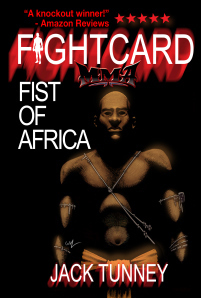 When I spoke to Paul Bishop – who, along with author Mel Odom created the Fight Card concept – he expressed an interest in my protagonist, Nick ‘New Breed’ Steed and the story of his coming of age as a fighter in the Adewale Wrestling Compound in Oṣogbo, Oṣun State, Nigeria. I was happy because I have always wanted to share with the world the fierceness, efficiency and effectiveness of the indigenous African martial arts for self-defense, as well as their transformative powers in the building of men and women with self-discipline, courage and good character. Fight Card MMA was a perfect outlet for my unique brand of Fight Fiction, which I am sure you will enjoy reading as much as I enjoyed writing it.
When I spoke to Paul Bishop – who, along with author Mel Odom created the Fight Card concept – he expressed an interest in my protagonist, Nick ‘New Breed’ Steed and the story of his coming of age as a fighter in the Adewale Wrestling Compound in Oṣogbo, Oṣun State, Nigeria. I was happy because I have always wanted to share with the world the fierceness, efficiency and effectiveness of the indigenous African martial arts for self-defense, as well as their transformative powers in the building of men and women with self-discipline, courage and good character. Fight Card MMA was a perfect outlet for my unique brand of Fight Fiction, which I am sure you will enjoy reading as much as I enjoyed writing it.In Fist of Africa, readers will experience jaw-dropping action on the mean streets of Chicago, in the sand pits of Nigeria and in cages in the “Dirty South” (Atlanta).
2014 also offers a full slate of monthly Fight Card titles along with further Fight Card MMA, Fight Card Romance, and Fight Card Now titles, as well as the debut of the Fight Card Luchadores brand, set in the world of Mexican Masked wrestling.
My first Fight Fiction novella, A Single Link, while very different from Fist of Africa, is set in the same universe, thirty years in the future and some of the characters from Fist of Africa make appearances in it. I will be publishing several other books in this universe, as well and I am even working on a Luchadores Fight Fiction / Science Fiction / Horror mash-up (my homage to Luchador and Nollywood films) set in Mexico, Egypt and Nigeria.
But, for now, enjoy Fist of Africa and please, drop me a line to let me know what you think of it and, if you like it – and you will – help a brother out and give him a review.


February 2, 2014
THE SCYTHE HAS RISEN! Dieselfunk has emerged and the Roaring Twenties will never seem the same!
Dieselfunk has emerged and the Roaring Twenties will never seem the same!
 The very first Dieselfunk novel, The Scythe, is now available in both paperback and e-book formats!
The very first Dieselfunk novel, The Scythe, is now available in both paperback and e-book formats!
Here’s a peek at what it’s about:
Out of the tragedy of the Tulsa Race Riot of 1921, a two-fisted hero rises from the grave!
Dr. A. C. Jackson has been given a second chance at life. A second chance at revenge. He is the bridge between the Quick and the Dead.
He is…THE SCYTHE!
 Inspired by the pulp magazines of the 1930s and 1940s, a tale of action, adventure, thrills and chills await fans of Dieselpunk, die-hard pulp fans and readers who just love a gritty story that packs a mean punch.
Inspired by the pulp magazines of the 1930s and 1940s, a tale of action, adventure, thrills and chills await fans of Dieselpunk, die-hard pulp fans and readers who just love a gritty story that packs a mean punch.
Enter a world in which Gangsters, Flappers, vampires, robots and the Ku Klux Klan all roam the same dark back streets; a world of grit, grime and grease; a world of hardboiled gumshoe detectives and mad scientists; a world where magic and technology compete for rule over the world.
Dieselfunk has emerged in The Scythe…and the Roaring Twenties will never seem the same!
*This novel also contains the illustrated short story, La Vipère Noire and the Initiation at Pic la Selle (illustrated by the Blacktastic artist Chris Miller) and other goodies!
**Cover art by Stanley “Standingo” Weaver, Jr.!


January 28, 2014
I KNOW YOU ARE, BUT WHAT AM I? Steamfunk and Dieselfunk are Racist!
I KNOW YOU ARE, BUT WHAT AM I?
Steamfunk and Dieselfunk is Racist!
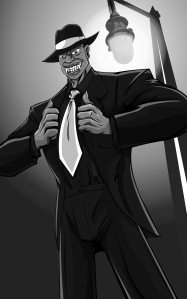 Two days ago, I posted an article about my Dieselfunk novel, The Scythe, premiering at AnachroCon in February. I also mentioned that this year, AnachroCon’s theme is Dieselpunk.
Two days ago, I posted an article about my Dieselfunk novel, The Scythe, premiering at AnachroCon in February. I also mentioned that this year, AnachroCon’s theme is Dieselpunk.
Yesterday, this was all brought up by author and Dieselpunk, Jack Philpott, who inquired if the founder of Dieselpunks.org – the premier Dieselpunk social website – knew of AnachroCon’s Dieselpunk theme.
Here is the inquiry:
Tome, Larry, Johnny,
I just heard that Anachrocon in Atlanta 14-16 Feb (http://www.anachrocon.org/) is having a Dieselpunk theme this year. Balogun Ojetade (CC) is even releasing a Dieselfunk book there. Had any of you heard of that? Anyone have plans to be there (aside from Balogun)?
Jack…
 Here is the answer from the Creator / Editor of Dieselpunks.org, Tome Wilson (the bold emphasis is mine; the words, however, are all Tome’s):
Here is the answer from the Creator / Editor of Dieselpunks.org, Tome Wilson (the bold emphasis is mine; the words, however, are all Tome’s):
Hi Jack, This is the first I’m hearing of it. Granted, I don’t pay much attention to “dieselfunk,” because it’s racist, but I didn’t even see the event across the wire. Things are bad at work in February due to the Olympics and SuperBowl, so I won’t be able to make it to Atlanta. All of the projects that have been put on hold will be lava hot emergencies once the big events are over. I probably won’t see daylight again until March. –Tome
Hell, I didn’t know Dieselfunk was racist, but if Tome Wilson, the Creator and Editor of Dieselpunks, says so, it – and by default, I – must be, right?
But wait…there is more proof that Dieselfunk – and Steamfunk, by the way – is racist. This time, Dieselfunk and Steamfunk are exposed by – horror of horrors – Lt. Condor of Dragonfly Armory. Check it out. Oh…and once again, the bold emphasis is mine, but not the words:

Dragonfly Armory
from JC Barger Photography.
It is kinda crappy that the rest of the world is not represented in most Dieselpunk media. I haven’t seen many of the films or TV shows but I get the point just from looking at the previews and posters. There should be more representation for the other nations that participated in these wars and all of the people who fought.
On the same page though, you have to factor another point in. What if there is just a lack of interest among minorities? The Dragonfly Armory is a private organized group that is nothing but white people, but that isn’t because we’re excluding someone who’s asian, latino, black, or middle eastern. In fact I’m sure we would welcome that diversity. We, as far as I know, have never had anyone show interest before. I don’t think it’s too much of an assumption either to say that it’s not that the writers/directors are making these films such that minorities can’t be in them. Rather it is more that there isn’t an interest among prominent actors, who are minorities, to have a part in these films.
I could be completely off base in this assumption, there may be many actors who wish they could be a part of something like this. I feel that if that were the case though, there would be a larger presence of minorities in both the culture, and the con scene.
What upsets me the most about this though is the emergence of Steamfunk and Dieselfunk . To me this goes back to so many other aspects of society and culture that I won’t even begin to reference… The point is your right hand is saying that you want to be included, and treated equal. While your left hand is creating a situation where you are being exclusive and segregating every other race out.
Dieselpunk is in no way racist, exclusive, or prejudiced against any group of people. Except perhaps those who support Nazis…we don’t really want to have anything to do with them.
Dieselfunk though…by the very name of it you’re basically saying this can only be black people . Why would you create something that excludes you from the rest of society? Why make a subset of a culture exclusive to your own race instead of just joining into what’s already established? No one is excluding you, you clearly just don’t want to be involved.
This is why I can’t stand it when people say : “I don’t support this because its racist.” “We want to be treated the same.” etc… And then you go out and support something that is racist, just racist in your favor, that excludes you from being treated as the same since you are separating yourself from the rest of the races in the world.
Racism and segregation will continue to persist in this world as long as there are people who buy into the idea that the exclusion of the majority and other minorities is okay as long as you accept your own minority.
All that said I really did enjoy the rest of the article. It was very well written and included a TON of links to other blogs and sources. I think it is definitely worth the read.
- Lt. Condor
Come on, Tome; come on, Lt. Condor…you can’t just call a subgenre and a movement racist all willy-nilly.
Only racists do that.
 First, let’s define racism. I mean the accepted sociological definition, not the willy-nilly one.
First, let’s define racism. I mean the accepted sociological definition, not the willy-nilly one.
The proper definition of racism, which is commonly used in academic research, and has been the accepted definition by sociologists and social psychologists for more than a decade is: “racism is prejudice plus power”.
Anyone can carry positive or negative stereotypes of others based on racial or cultural characteristics. Anyone can be prejudiced – can judge others based on preconceived notions about their ethnicity or race.
People of any race can commit acts of violence, mistreatment or ostracizing based on these stereotypes. A Chinese boy might beat up a Black boy because he doesn’t like Black boys. A Black person might refuse to associate with Latinos.
These two scenarios might be negative; they might be terrible…however, to be racist – rather than simply prejudiced – requires having institutional power. In North America, white people have the institutional power.
“White” is presented as the norm; the default, because white people have institutional power.
Notice how Tome and Lt. Condor can just label Steamfunk and Dieselfunk – and, by default, Milton Davis, Valjeanne Jeffers, Maurice Broaddus, Yours Truly and all the other Steamfunkateers – racist with no explanation; no evidence; without study or experience.
Just…willy-nilly.
Because racism is systematic, they get to label things willy-nilly. They get to have no real argument for their anger. They get to feel justified without justification. They get to say dumb shit without being regarded as dumb.
They are really just acting out because they can…and because they feel threatened.
They feel threatened because we aren’t just getting along to get along. We are challenging the racism, classism and sexism found in Dieselpunk and Steampunk; we are telling the stories that, until we came along, went untold.
They feel threatened because, contrary to the lie that our “right hand is saying that we want to be included, and treated equal”, we are practicing Dieselpunk and Steampunk on our own terms. We are not seeking inclusion in any Airships or Armories not of our own making. We are not saying we want to be treated equal; we are equal, damn how you treat us. Our work is proof of that.
If you do not feel threatened, why utilize the classic – and oh, so obvious – defense mechanism of projection? We only defend ourselves when we feel threatened.
What is projection, you ask?
 Projection is the psychological phenomenon where someone denies some aspect of their behavior or attitudes and assumes instead that someone else is acting out this behavior or attitude. Projection also extends to philosophies and knowledge.
Projection is the psychological phenomenon where someone denies some aspect of their behavior or attitudes and assumes instead that someone else is acting out this behavior or attitude. Projection also extends to philosophies and knowledge.
I am sure you have heard the old adage, “When you point one finger at someone, there are three fingers pointing back at you.”
We see in other people the very things we do not want to see in ourselves.
Thanks to the power of our unconscious minds, we can manipulate our picture of reality and see it as we wish to see it – usually in a way that initially makes us feel more comfortable.
By means of projection, we get rid of unwanted feelings and relocate them in someone else.
Sounds pretty cool, huh? Like some old Matrix-meets-Inception-meets Cloud Atlas-type s**t.
But, by their very nature, the projections we put out want to come back to us. They want to come home where they belong. And I’m packing their bags and sending their racist asses back to Tome and Lt. Condor and to all the other Dieselpunks and Steampunks who, instead of dealing with the racism in fandom, want to project it on to those who are actually working hard to make a difference; to those who have introduced Steampunk and Dieselpunk to People of Color all over the world as Steamfunk and Dieselfunk and have inspired them to take part in the cosplay and the cons; to purchase not only our books, but yours as well.
Steampunk and Dieselpunk have benefitted from our work and will continue to and we have done so without discriminating against anyone and certainly without being racist.
The fact is projection is one of the most destructive ways of handling our difficulties. We fare better in life when we take responsibility for ourselves – when we own the good, the bad, and the ugly that belongs to us.
Generally speaking, projection alienates others and says far more about our own insecurities than any real truths about other people.
People of Color – and many white people – in Steampunk and Dieselpunk have cried out for, and even demanded, a re-imagining of the XYZ-Punk genres and subgenres that highlights lesser known struggles and gives voice to underrepresented groups in Steam – and Diesel – punk. And we Steamfunkateers are delivering…in a big way.
 “It’s all just fun,” you say. “Why so serious?”
“It’s all just fun,” you say. “Why so serious?”
Shut up, Joker (the Heath Ledger version)!
Dieselpunk and Steampunk have great social, intellectual, artistic and political value, so, while cosplaying, reading your favorite XYZ-Punk novel, or engaging in a Bartitsu sparring match might, indeed, be fun, we won’t dismiss, or shy away from, any controversy, we will engage in intelligent discourse and action that raises awareness and appreciation of Steamfunk and Dieselfunk and we will continue to tell the stories that must be told.
If that makes you uncomfortable; if it causes you to project onto Dieselfunk and Steamfunk exactly what Dieselpunk and Steampunk still struggle with, so be it.
You’ll just give me more to blog about.


January 26, 2014
DIESELFUNK DEBUTS DURING BLACK HISTORY MONTH & AT ANACHROCON!
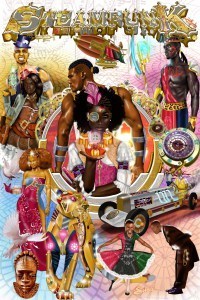 Last year, in celebration of Black History Month, author and publisher Milton Davis and Yours Truly released the history-making, ground breaking and earth shaking anthology Steamfunk, through Milton’s publishing company, MVmedia.
Last year, in celebration of Black History Month, author and publisher Milton Davis and Yours Truly released the history-making, ground breaking and earth shaking anthology Steamfunk, through Milton’s publishing company, MVmedia.
We unveiled Steamfunk at AnachroCon - the premier Historical Reenactment, Alternate History and Steampunk convention in the South – and the reception was amazing. Steamfunk has since gone on to be a bestseller for MVmedia and is even studied in colleges and universities throughout America.
This year, AnachroCon’s theme is Dieselpunk – a sub-genre of Science Fiction and Fantasy that includes – but is not limited to, or bound by – the aesthetics, style and philosophies of film noir and pulp fiction.
Dieselpunk features retrofuturistic innovations, alternate history and elements of the occult.
Think the movies Captain America: The First Avenger; Sin City; Hell Boy; the Indiana Jones films and The Mummy (1999 – 2008) trilogy.
 Often referred to as Steampunk’s grittier sibling, Dieselpunk is set during the Diesel Era – a period of time that begins at the end of World War I and continues until the early 1950s.
Often referred to as Steampunk’s grittier sibling, Dieselpunk is set during the Diesel Era – a period of time that begins at the end of World War I and continues until the early 1950s.
When the Dieselpunk theme for 2014 was announced at AnachroCon’s closing ceremonies last year, I was tickled because I had already planned to release the first Dieselfunk novel in history in early 2014. Thus, The Scythe will debut at this year’s AnachroCon!
What, exactly, is Dieselfunk, you ask?
Dieselfunk is fiction, film and fashion that combines the style and mood Dieselpunk with Afrofuturistic inspiration.
Dieselfunk tells the exciting untold stories of people of African descent during the Jazz Age.
Think the Harlem Renaissance meets Science Fiction…think Chalky White (from Boardwalk Empire) doing battle with robots run amok in his territory… think Mob bosses; Nazis; flappers. Jazz; bootleggers; Bessie Coleman; Marcus Garvey; the Tulsa Race Riots…that is Dieselfunk!
Since Dieselfunk is so wrapped up in Black History, it is the perfect type of writing to release during Black History Month.
For those who just can’t wait until February 14 to get your copy of The Scythe and you just gotta know what it is about, here is a sneak peek at the blurb on the books back cover:
 “He has been given a second chance at life; a second chance at revenge. He is the bridge between the Quick and the Dead. He is…THE SCYTHE!
“He has been given a second chance at life; a second chance at revenge. He is the bridge between the Quick and the Dead. He is…THE SCYTHE!
Out of the tragedy of the Tulsa Race Riot of 1921, a two-fisted hero rises from the grave!
Inspired by the pulp magazines of the 1930s and 1940s, a tale of action, adventure, thrills and chills await fans of Dieselpunk, die-hard pulp fans and readers who just love a gritty story that packs a mean punch.
Enter a world in which gangsters, flappers, vampires, robots and the Ku Klux Klan all roam the same dark back streets; a world of grit, grime and grease; a world of hardboiled gumshoe detectives and mad scientists; a world where magic and technology compete for rule over the world.
Dieselfunk has emerged in The Scythe…and the Roaring Twenties will never seem the same!”
And The Scythe is just the beginning for Dieselfunk. Milton Davis and I have discussed publishing the Dieselfunk anthology as a follow up to the popular Steamfunk anthology and The Scythe II will release at the end of this year.
Join me at AnachroCon February 14-16 and I will be happy to autograph your copy of The Scythe for you. If you can’t make it to AnachroCon this year, buy the book anyway and treat yourself to a great read.
Of course, I’ll still sign it for you whenever I see you, ‘cause we cool like that.
.









